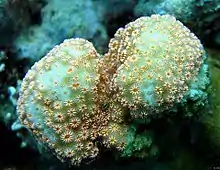Pavona maldivensis
Pavona maldivensis is a species of colonial stony coral in the family Agariciidae. It is found on shallow reef slopes, particularly those with strong wave action, and on vertical surfaces, in tropical parts of the Indian and Pacific Oceans.[1]
| Pavona maldivensis | |
|---|---|
 | |
| Scientific classification | |
| Kingdom: | Animalia |
| Phylum: | Cnidaria |
| Class: | Anthozoa |
| Order: | Scleractinia |
| Family: | Agariciidae |
| Genus: | Pavona |
| Species: | P. maldivensis |
| Binomial name | |
| Pavona maldivensis | |
| Synonyms[2] | |
| |
Description

Pavona maldivensis can be encrusting or massive, or a mixture of the two, and can form clumps over a metre in diameter, although colonies smaller than 30 cm (12 in) across are more usual. In areas with strong water movement they tend to form cylindrical, finger-like growths while elsewhere they may form horizontal plates, often with "leafy" edges. The corallites (stony cups in which the polyps sit) are circular and of irregular sizes, and have individual but indistinct stony walls. This coral is usually some shade of greyish-brown or green but can be bright orange.[2]
Distribution and habitat
Though named "of the Maldives" (maldivensis), P. maldivensis has a wide distribution in tropical and subtropical waters. Its range extends from the Red Sea, Gulf of Aden and Madagascar, through the southwestern and central Indian Ocean, northern Australia, southern Japan and the South China Sea, to the western, central and eastern Pacific Ocean.[1]
Ecology
Pavona maldivensis is a zooxanthellate species of coral; this means that its tissues contain symbiotic single celled algae which provide part of its nutritional requirements. These contain chlorophyll and tend to be some shade of brown or green, but in this coral there is an additional photosynthetic pigment, phycoerythrin. In daylight, this absorbs light at one wavelength and transmits it at another, giving a bright orange fluorescence.[3][4]
In aquaria
Pavona maldivensis and other species in this genus are kept in reef aquariums where they are said to be easy small stony corals for beginners to care for.[5]
References
- Hoeksema, B.W.; Rogers, A.; Quibilan, M.C. (2014). "Pavona maldivensis". IUCN Red List of Threatened Species. 2014: e.T132911A54159304. doi:10.2305/IUCN.UK.2014-1.RLTS.T132911A54159304.en.
- Hoeksema, Bert (2017). "Pavona maldivensis (Gardiner, 1905)". WoRMS. World Register of Marine Species. Retrieved 12 August 2017.
- Heemsoth, Amy (3 August 2017). "What makes colorful corals colorful?". Colorful Coral in Lau, Fiji. Khaled bin Sultan Living Oceans Foundation. Retrieved 12 August 2017.
- Schlichter, D.; Meier, U.; Fricke, H.W. (1994). "Improvement of photosynthesis in zooxanthellate corals by autofluorescent chromatophores". Oecologia. 99 (1–2): 124–131. doi:10.1007/BF00317092.
- "Maldive coral". Animal-World. Retrieved 13 August 2017.
